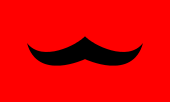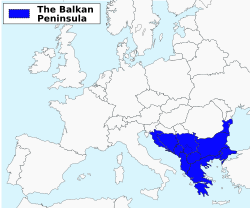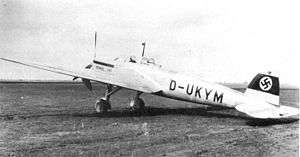Borduria
| Borduria | |
|---|---|
 Flag | |
 General location of Borduria and Syldavia | |
| The Adventures of Tintin location | |
| Other name(s) | Republic of Borduria |
| Created by | Hergé |
| Type | Semi-totalitarian Fascist dictatorship |
| Ruler | Marshal Kûrvi-Tasch |
| Ethnic group(s) | Bordurian (Mixed Ottoman Turkish and Southern Slavic roots) |
| Notable locations | Szohôd (capital) |
| Language(s) | Bordurian |
| Currency | Bordurian Dinar |
Borduria is a fictional country in The Adventures of Tintin, the comics series by Belgian cartoonist Hergé. It is located in the Balkans and has a rivalry with the fictional neighbouring country of Syldavia. Borduria is depicted in King Ottokar's Sceptre and The Calculus Affair, and is referred to in Tintin and the Picaros.
Appearances in Tintin books
In King Ottokar's Sceptre, Tintin reads a Syldavian tourist pamphlet that reveals the early history of Syldavia and its relationship with Borduria. In 1195, Syldavia was annexed by neighbouring Borduria due to the weakness of King Muskar II, and was under its rule until 1275, when Baron Almaszout drove the Bordurians away and established himself as King Ottokar I. In the later Tintin stories, this ancient rivalry continues with the Bordurians continually trying to invade or undermine Syldavia.

King Ottokar's Sceptre (written in 1939 by Hergé) depicts an unsuccessful Bordurian attempt at staging a coup d'état against Syldavia, trying to remove the king and invade the country with the support from Syldavian sympathizers. The sceptre is stolen, which would force the King to abdicate, however Tintin returns it in time. The Bordurians then withdraw their troops 15 miles from the borders to prove their peaceful intentions.
In The Calculus Affair (1956), Borduria is depicted as a stereotypical half-Eastern Bloc and half-fascist country complete with its own secret police (ZEP) (led by Colonel Sponsz) and a fascist military dictator, Marshal Kûrvi-Tasch, who promotes a Taschist ideology. A statue of Kûrvi-Tasch appears in front of a government building, in which he wears a moustache similar to Joseph Stalin's and gives a Nazi-like salute. The Bordurian military of this period is depicted as technologically inept—unable to stop a stolen tank commandeered by Tintin and his companions as a result of defective mines and anti-tank guns. Professor Calculus is kidnapped by the Bordurians after developing an ultrasonic weapon but is rescued in the end.
In Tintin and the Picaros (1976), the South American banana republic of San Theodoros, ruled by General Tapioca, has formed an alliance with the Bordurian government, which has sent him military advisors, including Colonel Sponsz. In an unpublished page drawn by Hergé for this book, a bust of Kûrvi-Tasch can even be seen in the office of a San Theodorean colonel. Eventually, Tapioca is deposed by Tintin's friend General Alcazar, and Sponsz is exiled.
Geography
The Bordurian countryside is set in dramatic mountainous terrain. The craggy landscape and towering peaks are most similar to the Balkan Mountains in Moesia. Therefore, it is possible that Borduria is set roughly in the present-day locations of Bulgaria and Serbia. The capital of Borduria is Szohôd, which is also the seat of government.
Government and military
.svg.png)

.svg.png)

.svg.png)
Borduria is a fascist country with a semi totalitarian government. Several Eastern European countries such as Hungary, Croatia, Albania and Romania were run by fascist governments before and during World War II. All became client states of the Soviet Union after the war; Borduria may be presumed to be in a similar situation. In Tintin post-war stories it is depicted as a typical Eastern Bloc country. The fact that the president of state bears the military rank of Marshal is a reference to Soviet leader Joseph Stalin, Romania's wartime leader Ion Antonescu and Yugoslavia's post-war president Josip Broz Tito. However, the leader's cult of personality most resembles Joseph Stalin.
The army in pre-war King Ottokar's Sceptre is depicted as Nazi-supplied, the main aircraft being Bf-109. In post-war stories it has all the characteristics of the Soviet military. In Tintin and the Picaros the San Theodoros army is supplied by Borduria with Beretta AR70/90 assault-rifles and Mil Mi-1 helicopters. Also the government state limousine with Kurvi-Tasch's mustaches is inspired by the Soviet ZIL-111.
In King Ottokar's Sceptre, the Bordurian flag is black with a red circle and two black triangles, reminiscent of the stark, eye-catching symbols used by several Fascist movements. In The Calculus Affair, it is red, with the emblem of Kurvi-Tasch's mustache inside a white circle, resembling it closer to the Nazi flag, and this was also worn as military armbands by the Bordurian military personnel. In King Ottokar's Sceptre, the Bordurian army uses the Gewehr 98, vz. 24 and Karabiner 98k bolt action rifles. In The Calculus Affair, Bordurian soldiers and agents were armed with Italian Beretta Model 38 Submachine Guns. Due to the nature of its government and its military's weaponry, Borduria was most likely an affiliate of the Axis during World War II, although there is no explicit mention of that in the books.
The post-war emblem of Borduria is similar to the circumflex symbol, and is modelled in the likeness of the mustache of Marshal Kûrvi-Tasch. In The Calculus Affair, evidence of the cult of personality surrounding the Marshal can be found in countless objects in Borduria, from the lettering on signs and buildings to the logos of Bordurian companies and even certain characteristics and details on cars, including the car bumpers, include the shape in their designs.
Language
The Tintin books depict the country's language, Bordurian, only in fragments. Like Syldavian, the language seems to be based on the Dutch Brussels dialect Marols, such as "mänhir" for "mister" or "sir" (cf. Dutch mijnheer). Unlike Syldavian, it uses the Latin alphabet exclusively, and makes heavy use of the digraph sz (possibly borrowed from Hungarian), as well as ô.
People and history
(Although the history and people of Borduria have not been described in detail by Hergé in Tintin, the comics leave creative license to imagine possible narratives for these aspects of the fictional nation.)
Nomadic Slavs inhabited the modern-day regions of Borduria and Syldavia during the days of the Byzantine Empire until the arrival of the Ottoman Turks during the 16th century under Suleiman the Magnificent. All this followed the Turkish defeat at the hand of the Syldavians during the 12th century. Although the Turks allowed the Bordurians to retain their own Slavic identity, the Turkish language, Ottoman architecture, and culture quickly assimilated into the Bordurian Slavic culture, and created an identity strikingly Turko-Slavic. Throughout the Tintin comics, the Bordurians are portrayed as a typical ethnicity of the Balkans with both Ottoman and Slavic influences, not unlike the Bosnians or Albanians (in the Calculus Affair, Middle Eastern architecture is presented in the background of Tasch Platz when Tintin is being driven to his hotel). Following a wake of extreme national self-determination against the Austro-Hungarians, who had invaded the Balkans during phase of weakness of the Ottoman Empire prior to the First World War, Borduria's position in the crossfire between the Austro-Hungarian and Serbian conflict in 1914 severely unsettled its economy and still emerging democracy. Over-extending their power, the Bordurian government supported a movement to overthrow King Ottokar of Syldavia, and establish themselves as a hegemonial power in the Balkans in order to create a unified Southern Slavic kingdom.
Notes
| Wikimedia Commons has media related to Borduria. |